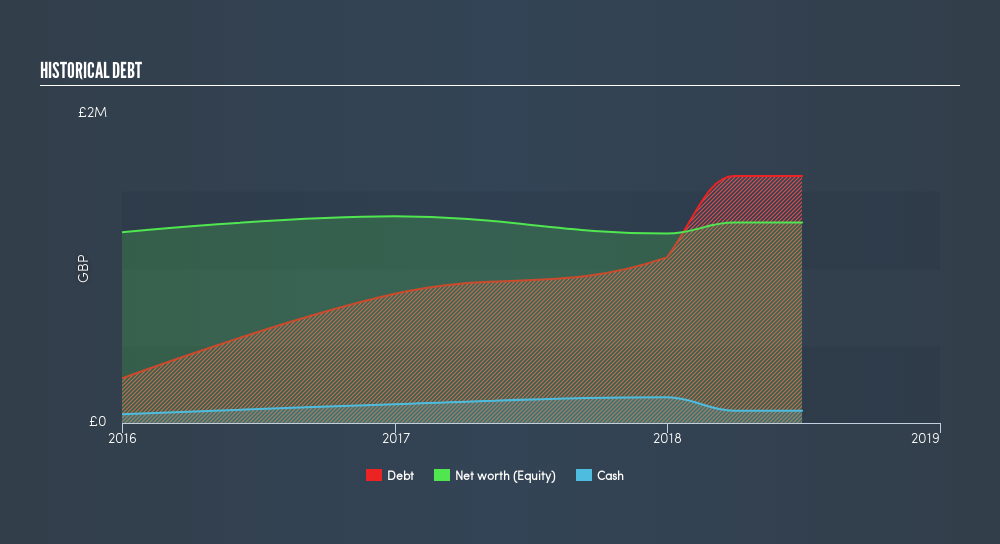You Might Like Trackwise Designs Plc (LON:TWD) But Do You Like Its Debt?

Investors are always looking for growth in small-cap stocks like Trackwise Designs Plc (LON:TWD), with a market cap of UK£15m. However, an important fact which most ignore is: how financially healthy is the business? Understanding the company's financial health becomes crucial, since poor capital management may bring about bankruptcies, which occur at a higher rate for small-caps. We'll look at some basic checks that can form a snapshot the company’s financial strength. Nevertheless, these checks don't give you a full picture, so I’d encourage you to dig deeper yourself into TWD here.
Does TWD Produce Much Cash Relative To Its Debt?
TWD has built up its total debt levels in the last twelve months, from UK£836k to UK£1.6m , which accounts for long term debt. With this increase in debt, TWD currently has UK£80k remaining in cash and short-term investments to keep the business going. Moreover, TWD has generated cash from operations of UK£236k over the same time period, resulting in an operating cash to total debt ratio of 15%, meaning that TWD’s debt is not covered by operating cash.
Can TWD meet its short-term obligations with the cash in hand?
With current liabilities at UK£2.3m, the company may not have an easy time meeting these commitments with a current assets level of UK£1.5m, leading to a current ratio of 0.64x. The current ratio is the number you get when you divide current assets by current liabilities.

Is TWD’s debt level acceptable?
With total debt exceeding equity, TWD is considered a highly levered company. This is somewhat unusual for small-caps companies, since lenders are often hesitant to provide attractive interest rates to less-established businesses. We can test if TWD’s debt levels are sustainable by measuring interest payments against earnings of a company. Ideally, earnings before interest and tax (EBIT) should cover net interest by at least three times. For TWD, the ratio of 1.35x suggests that interest is not strongly covered, which means that debtors may be less inclined to loan the company more money, reducing its headroom for growth through debt.
Next Steps:
Although TWD’s debt level is towards the higher end of the spectrum, its cash flow coverage seems adequate to meet debt obligations which means its debt is being efficiently utilised. However, its low liquidity raises concerns over whether current asset management practices are properly implemented for the small-cap. This is only a rough assessment of financial health, and I'm sure TWD has company-specific issues impacting its capital structure decisions. I recommend you continue to research Trackwise Designs to get a more holistic view of the stock by looking at:
- Future Outlook: What are well-informed industry analysts predicting for TWD’s future growth? Take a look at our free research report of analyst consensus for TWD’s outlook.
- Valuation: What is TWD worth today? Is the stock undervalued, even when its growth outlook is factored into its intrinsic value? The intrinsic value infographic in our free research report helps visualize whether TWD is currently mispriced by the market.
- Other High-Performing Stocks: Are there other stocks that provide better prospects with proven track records? Explore our free list of these great stocks here.
We aim to bring you long-term focused research analysis driven by fundamental data. Note that our analysis may not factor in the latest price-sensitive company announcements or qualitative material.
If you spot an error that warrants correction, please contact the editor at editorial-team@simplywallst.com. This article by Simply Wall St is general in nature. It does not constitute a recommendation to buy or sell any stock, and does not take account of your objectives, or your financial situation. Simply Wall St has no position in the stocks mentioned. Thank you for reading.
About AIM:TWD
Trackwise Designs
Trackwise Designs plc designs, develops, manufactures, and sells printed circuit boards in the United Kingdom, Europe, and internationally.
Adequate balance sheet and slightly overvalued.
Similar Companies
Market Insights
Community Narratives





